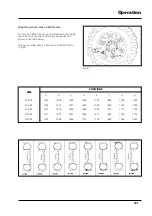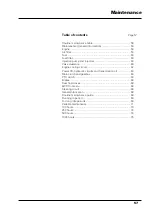
47
Operation
Towing attachments
Class C tow hook
A class C tow hook (Fig. 27) may be fitted for towing
single or twin axle agricultural implements and trailers.
To make hitching the implement easier, this device can
be adjusted in height. It can be set both over and under
the PTO shaft in a total of 4 positions ranging from a
minimum 45 mm (1.77 in.) to a maximum 770 mm
(30.34 in.) (Fig. 28).
To re-position the tow hook, pull out the securing pins
(1) to free the hook and move it to the desired height.
Positioning of the how hook is extremely important.
Manoeuverability and stability in driving depends on
implements and trailers being hitched at the correct
height.
In the higher positions, the tow hook has a greater
towing capacity but the risk of lifting the tractors front
wheels is also greater.
When using the four wheel drive, keep the tow hook in
one of the lower positions so that the drawbar remains
as horizontal as possible. This keeps the weight over
the front axle and improves tractive force.
Class «A» swinging drawbar
The tractor can be equipped with a class A swinging
drawbar (3) designed only for agricultural implements
with two or more axles (Fig. 29).
Never use this type of attachment to tow single axle
implements and trailers because they can apply enough
weight to the drawbar to pitch the tractor up at the
front.
The drawbar (3) can be regulated in height to correctly
couple with both towed implements and those that
operate through the PTO.
The drawing (Fig. 30) shows the various distances that
can be obtained between the PTO shaft and the hitch
on the drawbar. Drawbar position can be varied by:
turning the drawbar upside down so that the hitch
lies over under the bar;
by varying the hinging point of the sector on the tractor
support
.
Fig. 27 Class C tow hook.
Fig. 28 Class C tow hook positions.
Fig. 29 Class A drawbar.
5860-6060
6860
7860
8860
A
440
468
517
552
B
540
568
617
652
C
665
693
742
777
D
765
793
842
877
















































